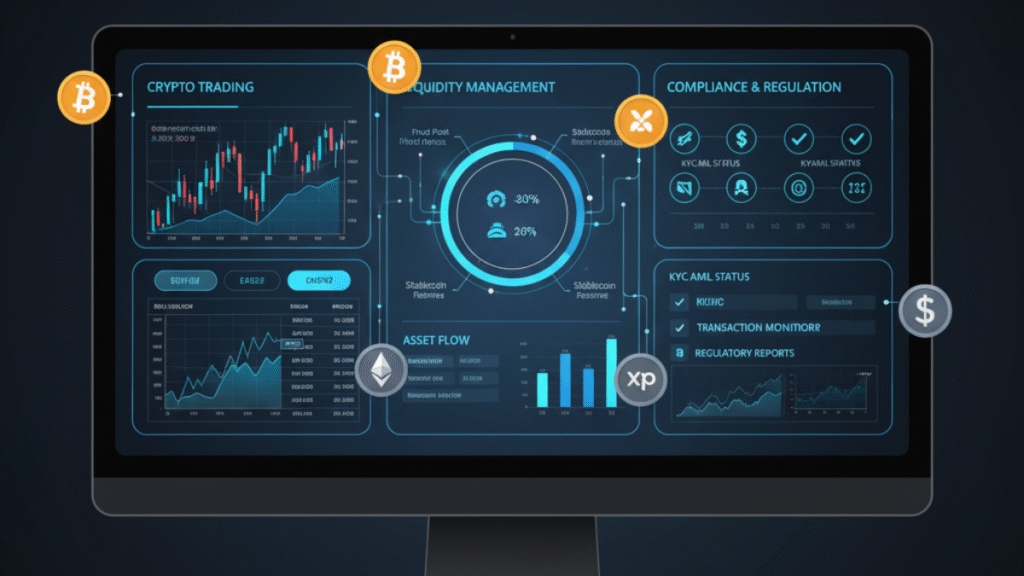Binance, the world’s largest cryptocurrency exchange, has launched Crypto-as-a-Service (CaaS), a new white-label solution designed for banks, brokerages, and financial institutions. This platform allows traditional financial companies to offer crypto trading and related services to their clients without building complex systems from scratch.
With CaaS, institutions can access Binance’s spot and futures markets, liquidity pools, custody solutions, compliance tools, and settlement services. Importantly, they maintain full control over their brand, user experience, and client relationships, while Binance manages the technical and operational backend.
Key features include internalized trading, where orders between clients can be matched within the institution, and direct access to Binance’s global orderbook for better execution and tighter spreads. A dedicated management dashboard enables institutions to monitor trading activity, client onboarding, and asset flows, while client management tools allow personalized trading experiences.
This move reflects the growing demand for digital assets among clients of traditional financial institutions. By offering a plug-and-play infrastructure, Binance simplifies adoption, reduces operational risk, and accelerates time-to-market for crypto services.
Early access to CaaS begins in September 2025, with a wider rollout planned for Q4 2025, signaling a major step in bridging traditional finance and the crypto world.
What Is Crypto-as-a-Service?
Crypto-as-a-Service, or CaaS, is a white-label solution. In simple words, it means that Binance builds the complicated back-end technology, while banks and financial institutions get to use it under their own brand name.
For example, imagine you’re a customer of a traditional bank. Instead of signing up separately for a crypto exchange, you could directly buy, sell, or trade Bitcoin and other digital assets right from your banking app. Your bank would handle the user interface, while Binance’s technology powers everything in the background.
This approach saves time, reduces costs, and lowers the risks of mistakes for financial institutions.
Key Features of Binance’s CaaS
Binance’s new service isn’t just about trading. It offers a complete package that covers almost everything a financial institution would need to launch crypto services. Here are some of the highlights:
1. Internalized Trading
Institutions can match orders directly between their own clients. This means if one customer wants to sell Bitcoin and another wants to buy, the transaction can happen internally without needing outside liquidity. It makes trading faster and potentially more profitable for institutions.
2. Access to Global Liquidity
When internal liquidity isn’t enough, CaaS connects directly to Binance’s global order books for spot and futures markets. This gives institutions access to some of the deepest liquidity pools in the world, ensuring fair prices, tighter spreads, and smooth execution.
3. Management Dashboard
Binance has built a dedicated dashboard for institutions. This tool helps them track trading volumes, asset flows, client onboarding, and trade distribution. Institutions can also manage sub-accounts, commissions, and other operational settings with ease.
4. Client Management Tools
Financial institutions can segment their clients, apply different fee structures, and even design personalized trading experiences. For example, premium clients could receive better rates or advanced trading options, while casual users could get a simpler interface.
5. Custody and Compliance
Crypto regulation is a big challenge for traditional finance. Binance’s CaaS includes built-in tools for KYC (Know Your Customer), transaction monitoring, and secure asset custody. These features help institutions stay compliant with local and international regulations.
Why Is Binance Doing This?
According to Catherine Chen, Head of VIP & Institutional at Binance, demand for digital assets is growing too fast for traditional financial institutions to ignore. Building crypto services in-house can be complex, expensive, and risky.
That’s where Binance sees an opportunity. By offering a plug-and-play infrastructure, the company allows banks and brokerages to focus on their brand and customer relationships, while Binance handles the complicated technical side.
In Chen’s words:
“Traditional financial institutions can no longer afford to be on the sidelines. CaaS is a trusted, ready-made solution that lets institutions focus on what matters most: their clients.”
Competition with Coinbase
Binance isn’t the only exchange offering this kind of service. Earlier in June 2025, Coinbase also launched a similar product aimed at financial institutions.
This means competition is heating up between the two biggest crypto exchanges in the world. Both companies are betting that the next wave of growth in crypto won’t come only from individual retail investors, but from traditional finance (TradFi) adopting crypto at scale.
Why This Matters for Traditional Finance
For decades, banks have been cautious about crypto. Many only offered indirect exposure through exchange-traded funds (ETFs) or stocks of companies holding cryptocurrencies. But now, the pressure is mounting:
- Client Demand: More customers are asking their banks for direct access to crypto trading.
- Regulatory Shifts: Governments, especially in the U.S., are creating clearer rules for digital assets. Under President Donald Trump’s crypto-friendly policies, Wall Street has gained confidence to move forward.
- Global Competition: Countries like Kazakhstan and others are experimenting with state-backed crypto funds, pushing financial institutions to keep up.
Binance’s CaaS could give banks and brokerages the tools they need to quickly meet this demand.
The Roadmap for CaaS
The rollout of Binance’s CaaS will happen in phases:
- Early Access (Sept 30, 2025): A select group of licensed banks, brokerages, and exchanges will test the platform through private demos.
- Q4 2025: Wider rollout to more institutions around the world.
- Full Support by 2026: Binance expects the platform to be fully operational with all features available.
This step-by-step approach ensures that the platform is tested, refined, and ready for large-scale adoption.
What This Means for Everyday Users
For the average customer, this could mean that your local bank or brokerage app might soon include crypto services. Instead of signing up for separate exchanges, you’ll be able to:
- Buy and sell crypto directly through your bank.
- Trade with the same security and compliance standards you expect from traditional finance.
- Get access to better liquidity and prices thanks to Binance’s global infrastructure.
This move could make crypto more accessible to millions of new users who may have avoided it due to complexity or lack of trust.

Last Words
Binance’s Crypto-as-a-Service represents a major milestone in the merging of traditional finance and digital assets. By offering a turnkey, white-label infrastructure, Binance is lowering the barriers for banks and institutions to enter the crypto market.
With strong competition from Coinbase and growing global demand for digital assets, the financial industry is moving closer to a future where crypto services are as common as checking accounts or stock trading.
For institutions, it’s a chance to innovate without the heavy costs of building new systems. For customers, it means more choices, more trust, and easier access to crypto.
As regulations continue to develop and technology improves, solutions like Binance’s CaaS could be the bridge that finally connects traditional finance and the world of digital assets.
Q&A: Binance Crypto-as-a-Service for Banks and Institutions
Q1: What is Binance Crypto-as-a-Service (CaaS)?
A1: CaaS is a ready-made platform from Binance. It helps banks and financial companies offer crypto trading to their clients without having to build complicated systems themselves.
Q2: Who can use CaaS?
A2: Licensed banks, brokerages, and other financial institutions can use it. Early access starts in September 2025, and more institutions can join in Q4 2025.
Q3: What does CaaS include?
A3: It offers tools like internalized trading, access to Binance’s spot and futures markets, liquidity pools, secure custody, compliance tools, settlement services, a dashboard to track activity, and client management features.
Q4: Can institutions make it their own?
A4: Yes. They can keep their brand, control the user experience, and manage their clients, while Binance handles all the technical backend work.
Q5: Why is Binance launching CaaS now?
A5: More people and clients want to trade crypto. Banks want to enter the market quickly, but building everything from scratch is costly and difficult.
Q6: How do customers benefit?
A6: Customers can trade crypto directly through their bank, enjoy better prices and liquidity, and use a secure, regulated platform.
…….
Read more Business Articles

